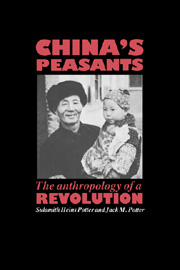Book contents
- Frontmatter
- Contents
- List of illustrations
- List of tables
- Preface
- Notes on the text
- Map 1 China
- 1 The old “feudal” order: Zengbu before Liberation
- 2 Establishing the new order
- 3 The ordeal of collectivization
- 4 The Cultural Revolution
- 5 Maoist society: the production team
- 6 Maoist society: the brigade
- 7 Maoist society: the commune
- 8 Impatient aspirations: transition to the post-Mao period
- 9 The cultural construction of emotion in rural Chinese social life
- 10 Marriage, household, and family form
- 11 Chinese birth planning: a cultural account
- 12 Lineage and collective: structure and praxis
- 13 Party organization
- 14 The party ethic: a devotion born of distress and enthusiasm
- 15 A caste-like system of social stratification: the position of peasants in modern China's social order
- 16 The Chinese peasants and the world capitalist system
- 17 The crystallization of post-Mao society: Zengbu in 1985
- References
- Index
13 - Party organization
Published online by Cambridge University Press: 02 December 2009
- Frontmatter
- Contents
- List of illustrations
- List of tables
- Preface
- Notes on the text
- Map 1 China
- 1 The old “feudal” order: Zengbu before Liberation
- 2 Establishing the new order
- 3 The ordeal of collectivization
- 4 The Cultural Revolution
- 5 Maoist society: the production team
- 6 Maoist society: the brigade
- 7 Maoist society: the commune
- 8 Impatient aspirations: transition to the post-Mao period
- 9 The cultural construction of emotion in rural Chinese social life
- 10 Marriage, household, and family form
- 11 Chinese birth planning: a cultural account
- 12 Lineage and collective: structure and praxis
- 13 Party organization
- 14 The party ethic: a devotion born of distress and enthusiasm
- 15 A caste-like system of social stratification: the position of peasants in modern China's social order
- 16 The Chinese peasants and the world capitalist system
- 17 The crystallization of post-Mao society: Zengbu in 1985
- References
- Index
Summary
The Communist party of China is the architect of modern Chinese society. Its record is one of enormous revolutionary accomplishment. From a small ragged band of marginal outlawed intellectuals in 1921, the party has become the largest political organization in world history and now decides the destinies of one-fifth of humankind. By successfully mobilizing the Chinese people to resist the Japanese during World War II the party rose to power. Then, organizing the poor and landless peasant masses of China, it decisively defeated the Guomindang in civil war. After Liberation, the party established China's full independence from foreign imperialism, broke the power of the landlords and capitalists – the old ruling elites – and, over the past three-and-one-half decades, has revolutionized the structure of the largest society on earth. Mistakes have been made – and they have cost dearly – but the party has succeeded in providing order, food, clothing, shelter, education, pride, and hope for a society that lacked even these bare human essentials prior to Liberation, in 1949. In the thirty-five years following Liberation, the party directed the industrialization and economic development of China. World Bank figures show that China's growth rates were among the highest in the world between 1950 and 1975 (see Rawski 1980, table 30). Unfortunately population increase has absorbed most of China's economic growth, stifling the country's development and preventing the people from prospering as much as they otherwise would have done.
- Type
- Chapter
- Information
- China's PeasantsThe Anthropology of a Revolution, pp. 270 - 282Publisher: Cambridge University PressPrint publication year: 1990



